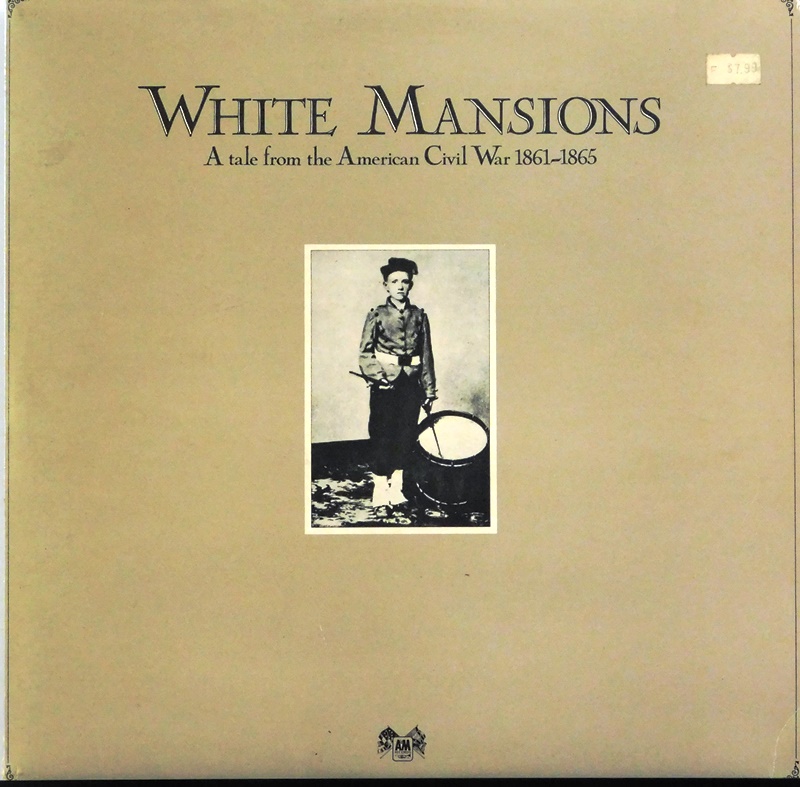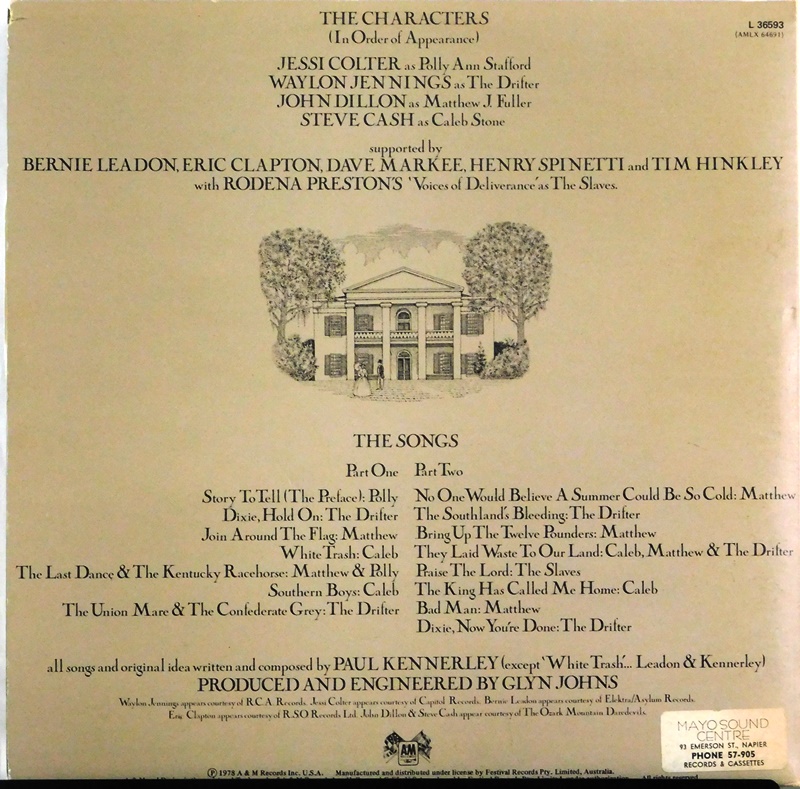

| Product Code: | L 36593 |
| Artist: | Various |
| Origin: | New Zealand |
| Label: | A&M (1978) |
| Format: | 2 X LP |
| Availability: | Enquire Now |
| Condition: |
Cover: VG+
Record: NM (M-)
|
| Genre: | Country Rock , Folk Rock , Rock , World U |
Very smart album housed in a nice crisp gatefold cover. Includes inner sleeve and 28 page booklet.
Who could imagine that one of the most compelling and overlooked country albums of all time sprung from the minds of an English songwriter, an English producer in Glyn Johns, and featured an English superstar in Eric Clapton? And yet that’s how the ambitious ‘concept’ album, White Mansions, came to be.
Released in June 1978 and produced by the legendary Glyn Johns, White Mansions paints a musical portrait of The American Civil War. It features the illustrious talents of Waylon Jennings and his then wife, Jessi Colter, Eagles guitarist Bernie Leadon, along with Eric Clapton, and John Dillon and Steve Cash of the Ozark Mountain Daredevils.
The genesis for this historical album didn’t come from Music City but an ex-ad man turned songwriter named Paul Kennerley, who was living in London when he first heard Jennings’ ‘Let’s All Help The Cowboys Sing The Blues’ and fell boots-first in love with country music. His almost obsessional interest in the Civil War set his songwriting in motion as he set about painstakingly researching the war to inform his lyrics with historical detail.
Kennerley had always felt Glyn Johns would be the ideal producer to help him with the project. By that time, Johns had already produced the Ozarks debut album and their follow-up, It’ll Shine When It Shines as well as Clapton’s solo record, Slowhand (among a host of other landmark works). The project came to Johns almost fully realized, with Kennerley going so far as to mailing him a folder of the lyrics and demos along with a handwritten letter. Glyn then took the idea to Derek Green and then Jerry Moss at A&M Records, who immediately signed Kennerley to a record and publishing deal.
Telling the story of Southern Pride from the vantage of four white Southerners during the Civil War was a hard sell, but it was slightly offset by the fact that it was being told from an outsider’s perspective with so much UK talent involved. In order to bring some authenticity to the project, Waylon Jennings was brought on board along with the Ozarks involvement.
Each musician was cast as a fictitious persona, who sing of the high hopes and deep sorrows of the Southern people through the eyes of the four main characters, who are each credited on the album rather than the musicians themselves. Jennings plays the “The Drifter” and serves as the album’s narrator who was wounded fighting in the Mexican War and roams from town to town. Ozarks vocalist John Dillon steps in as Matthew J. Fuller, the young son of a wealthy cotton planter who joins the Confederate Army as a captain.
Meanwhile fellow Ozark, Steve Cash, represents the poor Southern white class as Caleb Stone. For an album that’s almost structured like a mini-series, it needed a romantic interest, provided by Jessi Colter, who plays Matthew’s sweetheart, Polly Ann Stafford. Rounding out the cast is Rodena Preston (sister to Billy Preston) and her 40-strong choir as the ‘Voices of Deliverance’. These voices represent the freed slaves of the South, who as the liner notes state, “despite the fact that they represented over a third of the population of the South, their voice was seldom heard”.
Despite the source material, White Mansions is not traditional, mid-1800s folk music. There isn’t a single fiddle or field drum to be found, but instead it’s a prime example of Outlaw Country music, much in the style of Jennings at that time. From the excited anticipation of going to war with ‘Southern Boys’ and ‘Join Around the Flag’ to the bloody battlefields with ‘No One Would Believe This Summer Could Be So Cold’ and the inevitable desolation with, ‘The Southlands Bleeding’, the album narrates the undoing of the Southern state.
The history is heavy but some of the tracks are downright danceable, including Dillon’s bluegrass-fuelled ‘Join Around The Flag’ and Cash’s ‘Southern Boys’. Another highlight comes from real life couple, Jennings and Colter, who provide an emotional duet on, ‘The Union Mare and The Confederate Grey’.
As if this roaster wasn’t impressive enough, Johns assembled some of the best session musicians around when it came time to record at Olympic Studio, including stickman Henry Spinetti, bassist Dave Markee, keyboardist Tim Hinkley, Eagles guitarist Bernie Leadon and most famously, Eric Clapton, who plays slide guitar on a few tracks including, ‘White Trash’ and ‘The Last Dance And The Kentucky Racehorse’.
As Johns mentions in his autobiography, Sound Man: A Life Recording Hits with The Rolling Stones, The Who, Led Zeppelin, the Eagles, Eric Clapton, the Faces, “I have always loved the chemistry part of my job, mixing up musicians who have not played together before, particularly Americans and British”.
The album peaked at No.181 in the Billboard chart, and made No.38 on the Country album chart that same year. Promoting the album proved difficult, as A&M contractually was unable to use the names of the artists on the record. And because all the artists came from different labels, A&M struggled to get singles’ rights, explained Johns. Despite the limited radio play, the record has developed something of a cult appreciation over the last few decades.